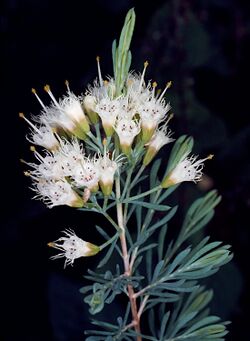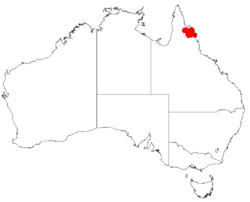Biology:Homoranthus tropicus
| Homoranthus tropicus | |
|---|---|

| |
| Homoranthus tropicus in the Australian National Botanic Gardens | |
| Scientific classification | |
| Kingdom: | Plantae |
| Clade: | Tracheophytes |
| Clade: | Angiosperms |
| Clade: | Eudicots |
| Clade: | Rosids |
| Order: | Myrtales |
| Family: | Myrtaceae |
| Genus: | Homoranthus |
| Species: | H. tropicus
|
| Binomial name | |
| Homoranthus tropicus Byrnes[1]
| |

| |
| Occurrence data from AVH | |
Homoranthus tropicus is a flowering plant in the family Myrtaceae and is endemic to tropical north Queensland. It is a shrub with curved, club-shaped leaves and white flowers in a corymb-like arrangement on the ends of branchlets.
Description
Homoranthus tropicus is a shrub to 1 m (3 ft 3 in) high. The leaves are arranged opposite, club-shaped, curved, shortly pointed and tapering at the base to a short petiole 4–8 mm (0.16–0.31 in) long, 0.5 mm (0.020 in) wide and marked with tiny dots. The white flowers are on a pedicel 0.5–1.5 mm (0.020–0.059 in) long, the small bracts 1–1.5 mm (0.039–0.059 in) long, keeled and ending in a short point. The calyx tube, distinctly angled and up to 3–4 mm (0.12–0.16 in) long, lobes 3–4 mm (0.12–0.16 in) long. The petals are broadly egg-shaped to almost round, margins smooth, about 2 mm (0.079 in) long and the style up to 7 mm (0.28 in) long. Flowering occurs sporadically throughout the year, primarily February to July and the fruit is a single seed retained in the calyx.[2][3]
Taxonomy and naming
Homoranthus tropicus was first formally described in 1981 by Norman Byrnes from a specimen he collected north of Laura in 1975 and the description was published in Austrolbaileya.[2][4] The specific epithet (tropicus) means "tropical".[5]
Distribution and habitat
This species grows in northern Queensland in heath or shrubby woodland on shallow rocky soils over sandstone.[3]
Conservation status
It has a restricted distribution and considered rare by Briggs and Leigh (1996) given a ROTAP conservation code of 2R.[3]
References
- ↑ "Homoranthus tropicus". Australian Plant Census. https://biodiversity.org.au/nsl/services/apc-format/display/103886.
- ↑ 2.0 2.1 Byrnes, Norman (1981). "Homoranthus tropicus". Austrobaileya 1 (4): 375. https://plants.jstor.org/stable/history/10.5555/al.ap.specimen.bri-aq0101774?loggedin=true. Retrieved 6 December 2021.
- ↑ 3.0 3.1 3.2 Copeland, Lachlan M.; Craven, Lyn A.; Bruhl, Jeremy J. (2011). "A taxonomic review of Homoranthus (Myrtaceae:Chamelaucieae)". Australian Systematic Botany 24 (6): 371. doi:10.1071/SB11015.
- ↑ "Homoranthus tropicus". APNI. https://id.biodiversity.org.au/instance/apni/532571. Retrieved 25 August 2018.
- ↑ Francis Aubie Sharr (2019). Western Australian Plant Names and their Meanings. Kardinya, Western Australia: Four Gables Press. p. 329. ISBN 9780958034180.
External links
Wikidata ☰ Q15367624 entry
 |

